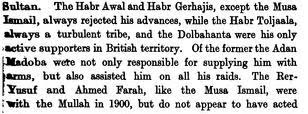







Shermaarke Saalax Baasha (1790-1861) the conqueror of Zaylac and the man who for the first time in Somali history brought Zaylac under the rule of Somalis, the first Somali Qadiif who in 1825 with 5 cannons and 60 H.Y musketeers took Zaylac and forced its Arab ruler Maxamed Al Baari out. He was accorded the title of Qadiif Al Soomaal by Cabdixamiid Baasha and was presented with two Arab and one Turkish slave women. The founder of what was referred to as the Government of Zaylac.
Sharmaarke Salax Baasha (1790-1861) was HY –Muse Carre- and the only Isaaq ruler and Emperior of Zaylac and Awdal.
Richard Burton
First footsteps in East Africa
Chapter 2
LIFE IN ZAYLA.
The ruler of saylac at that 1827 was Garxajis Before And After The Othmany Empire By :
Sh. Sharmarke Ali Saalax Basha 1827
Sharmarke wuxuu ka talinayay, magaalada Saylac muddo dheer, laga soo bilaabo 1827-kii ilaa waxyar ka hor markuu Ingirsiisku sida rasmiga ah u soo galay Somaliland. Sharmarke, waxa uu wakiil u ahaa maamul xoogganaa oo ka jiray Yaman, kaasoo uu siin jiray cashuur. Sharmarke, waxa uu ahaa nin soomaali ah, balse xiligaa, ahaa nin maalqabeen ah, nin fahamsan maamullada adduunka ka jira, nin soo arkay xilligaa adduunyada meelo kala fog. Nin la odhan jiray Johnston oo wax ka qoray Berbera iyo Saylac 1844-kii wuxuu ku tilmaamay Sharmarke, nin xooggan oo maamulkiisu dhisanyahay, isla markaana ah nin firfircoon. Richard Burton oo ahaa basaaskii qarnigaa ugu weynaa ee Somaliland soo gala, wuxuu isaguna ku tilmaamay nin xilligaa 1854-kii maamulkiisu xoogganaa, oo magaalada Saylacna lahayd dhawr irridood oo keliya, oo laga soo galo, ganacsi xoog-lihina ka socday.
Sheekh Sharmarke, wuxuu ka talinayay magaalada Saylac muddo ka badan 30 sannadood.
Chapter 2
Life in Zayla.
Richard Burton
One Salimayn, a black slave from the Sawahil24, now secretary to the Hajji, reads our fortunes in the rosary. The “fal”25, as it is called, acts a prominent part in Somali life. Some men are celebrated for accuracy of prediction; and in times of danger, when the human mind is ever open to the “fooleries of faith,” perpetual reference is made to their art. The worldly wise Salimayn, I observed, never sent away a questioner with an ill-omened reply, but he also regularly insisted upon the efficacy of sacrifice and almsgiving, which, as they would assuredly be neglected, afforded him an excuse in case of accident. Then we had a recital of the tales common to Africa, and perhaps to all the world. In modern France, as in ancient Italy, “versipelles” become wolves and hide themselves in the woods: in Persia they change themselves into bears, and in Bornou and Shoa assume the shapes of lions, hyenas, and leopards. 26 The origin of this metamorphic superstition is easily traceable, like man’s fetisism or demonology, to his fears: a Bedouin, for instance, becomes dreadful by the reputation of sorcery: bears and hyenas are equally terrible; and the two objects of horror are easily connected. Curious to say, individuals having this power were pointed out to me, and people pretended to discover it in their countenances: at Zayla I was shown a Bedouin, by name Farih Badaun, who notably became a hyena at times, for the purpose of tasting human blood.27 About forty years ago, three brothers, Kayna, Fardayna, and Sollan, were killed on Gulays near Berberah for the crime of metamorphosis. The charge is usually substantiated either by the bestial tail remaining appended to a part of the human shape which the owner has forgotten to rub against the magic tree, or by some peculiar wound which the beast received and the man retained. Kindred to this superstition is the belief that many of the Bedouins have learned the languages of birds and beasts. Another widely diffused fancy is that of the Aksar28."
http://ebooks.adelaide.edu.au/b/burton/richard/b97f/chapter2.html
http://www.workmall.com/wfb2001/somalia/somalia_history_the_somali_peninsula_on_the_eve_of_imperial_partition.html
http://www.country-data.com/cgi-bin/query/r-11950.html

























































